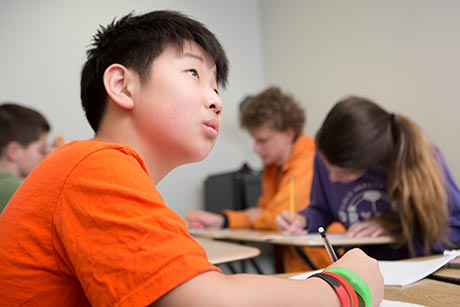Math Club connects Cornell students with local teens
By Anna Carmichael

Finding out how many people in New York City might be going bald may seem impossible, but for members of the Math Explorer’s Club, this is an opportunity to learn a new math technique and apply it to a real-life situation.
Throughout the year, Cornell’s math department in the College of Arts and Sciences runs the club for middle and high school kids. The club began with National Science Foundation support and uses modules developed with that funding.
The club aims to teach new and interesting concepts to students who are interested in learning about mathematics outside their regular school curriculum in an interactive and supportive learning environment.
Mary Ann Huntley, director of mathematics outreach and K-12 education for the department, said most of the participants come from schools near Ithaca, but the club this year also welcomed two students from Ohio.
The department offers three or four modules a year, with each module occurring on consecutive Saturdays. This semester they happened on April 11 and April 18, with a focus on combinatorics.
Ernest Chong, a graduate student who taught the combinatorics module, explained that this math comes in handy when you want to answer questions like, “How many of something do I have? How many ways can I arrange a number of things in a specific way? Are two sets the same size?”
Chong started the workshop off with an icebreaker to loosen up the kids and get them acquainted with one another. The activity also introduced them to the concept of combinatorics and how it applies to everyday situations.
“I love how this program makes concepts applicable,” said Camilla Pelliccia, 14. She explained that in school some of what she learned didn’t seem like it had a real-life purpose, but in the Math Explorer’s Club, she was able to “figure out the answer with math.”
During the program Chong, with two undergraduate assistants, applied combinatorics to several scenarios, one of which included finding out how many people in New York City had the same amount of hair on their head.
Club members come up with several different solutions offered by combinatorics.
“[Math is] a lot of different ways to solve something, so I can get creative,” said Dennis Kang, 12.
Although problems can be difficult to solve, Huntley said, “the kids’ faces light up” when they find the correct answer. The best part is seeing the “excitement that math holds for them.” She also is excited to see graduate students learn how to explain difficult problems in ways that middle and high school students can understand.
The club is a highly interactive experience for kids interested in math who “want to find out how it can apply to real-life situations,” said Carla Martinez, 12.
Anna Carmichael is a communications assistant for the College of Arts and Sciences.
Media Contact
Get Cornell news delivered right to your inbox.
Subscribe